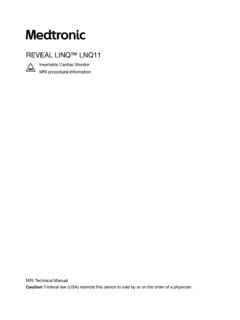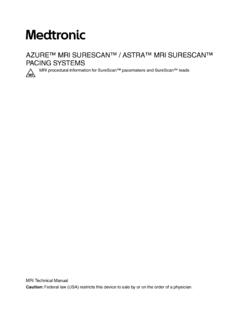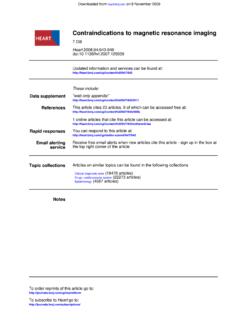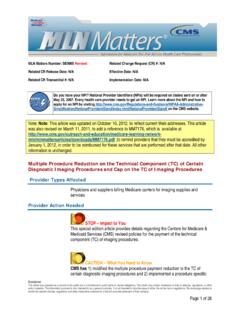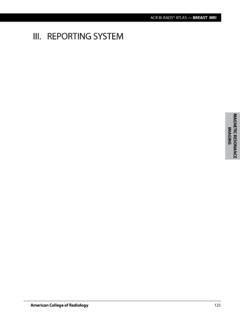Transcription of MRI guidelines for Medtronic implantable infusion systems ...
1 MRI guidelines for Medtronicimplantable infusion systems86378472 Instructions for useRx onlyExplanation of symbols on product or package labelingRefer to the appropriate product for symbols that resonance (MR) ConditionalMRMR Unsafe2020-05-01 MRI guidelines for Medtronic implantable infusion systems 8637 8472 English 3 Medtronic and Medtronic logo are trademarks of Medtronic . Third party brands aretrademarks of their respective owners. All other brands are trademarks of a English MRI guidelines for Medtronic implantable infusion systems 8637 8472 2020-05-01 Table of contentsIntroduction 7 Obtain the latest MRI guidelines labeling 7 Inactive implanted pumps 7 Schedule MRI 7 Minimizing image distortion 8 MRI information for Model 8637-20 and 8637-40 SynchroMed II pumps 9 MRI information for the Model 8472 IsoMed pump 14 MRI information for Model 8626 and 8627 SynchroMed EL pumps and theModels 8615, 8616, 8617.
2 And 8618 SynchroMed pumps 162020-05-01 MRI guidelines for Medtronic implantable infusion systems 8637 8472 English 56 English MRI guidelines for Medtronic implantable infusion systems 8637 8472 2020-05-01 IntroductionRead the appropriate pump section in this manual before performing a magneticresonance imaging (MRI) examination on a patient implanted with a Medtronic pump. Forinformation about how other forms of electromagnetic interference can affect the pump,see the implantable infusion systems information for prescribers a Medtronic representative if you have any questions about the information inthis manual. In the US, contact Medtronic Technical Services at any medical procedure is begun, patients must always inform any health carepersonnel that they have an implanted drug infusion system and share this informationabout MRI with the patient has multiple medical devices implanted, use the most restrictive MRIexposure requirements of the medical devices implanted.
3 Contact the appropriate devicemanufacturers if you have questions. If you are unclear what implants may be present,perform an x-ray to determine implant type and the latest MRI guidelines labelingAlways obtain the latest MRI guidelines . Refer to the contact information at the back ofthis manual, or go to of these MRI guidelines may not be the most up-to-date version available if notreceived directly from the website or in another manner from Medtronic the same day ofthe patient s MRI implanted pumpsSome older SynchroMed pump models may still be implanted in patients long aftertheir batteries have been depleted and drug delivery has ceased. These include theModel 8626 and 8627 SynchroMed EL pumps and the Models 8615, 8616, 8617, and8618 SynchroMed MRI safety and diagnostic information related to all inactive models, refer to theModel 8626 and 8627 SynchroMed EL pumps and the Models 8615, 8616, 8617, and8618 SynchroMed pumps section on page MRITo schedule an MRI for a patient with an implanted Medtronic infusion system: Identify the model number for the implanted Medtronic pump.
4 For MRI scheduling purposes only, see Table 1 to determine potential MRI scan-typeeligibility. If the pump model number is not known, ask the patient to look for the pump modelnumber on the Medtronic patient ID card, check with the pump clinician, or contactMedtronic Technical Services at to the MRI appointment, remind patients to do the following: Consult with the clinician who manages their infusion system Bring their pump patient ID card to the MRI appointment2020-05-01 MRI guidelines for Medtronic implantable infusion systems 8637 8472 English 7 Bring their Personal Therapy Manager (PTM) if they use the A820 myPTM app Inform the MRI clinician that they have an implanted deviceMRExternal devices are MR Unsafe in the scanner (magnet) room Do not allowthe following Medtronic external control devices into the MRI scanner (magnet) devices are MR Unsafe: Patient control devices (for example, patient programmer, patient handset, orcommunicator) Clinician programmer and communicatorTable 1.
5 MRI scan-type eligibilityPumpMRI equipmentPossible scanlocationsSynchroMed II: 8637-20, or 3-THead, torso,extremitiesIsoMed : , torso,extremitiesSynchroMed EL: 8626, 8627 SynchroMed: 8615, 8616, 8617, or 3-THead, torso,extremitiesMinimizing image distortionThe following information applies to all pump choice of pulse sequence parameters and location of the angle and location ofthe imaging plane may minimize MR image artifact; however, the reduction in imagedistortion obtained by adjustment of pulse sequence parameters will usually be at a costin signal-to-noise ratio. The following general principles should be followed: Use imaging sequences with stronger gradients for both slice and read encodingdirections.
6 Employ higher bandwidth for both radio-frequency pulse and datasampling. Choose an orientation for read-out axis that minimizes the appearance of in-planedistortion. Use spin echo or gradient echo MR imaging sequences with a relatively high datasampling bandwidth. Use shorter echo time for gradient echo technique, whenever possible. Be aware that the actual imaging slice shape can be curved in space due to thepresence of the field disturbance of the pump (as stated above). Identify the location of the implant in the patient, and when possible, orient allimaging slices away from the implanted English MRI guidelines for Medtronic implantable infusion systems 8637 8472 2020-05-01 MRI information for Model 8637-20 and 8637-40 SynchroMed II pumpsMR MR Conditional: If the patient is implanted with a Medtronic SynchroMed II pump,MRI examinations of the entire body may be safely performed under the followingconditions: (T) and 3-T horizontal cylindrical system for hydrogen imaging Radio-frequency (RF) coil: Any type Maximum spatial field gradient of 19T/m (1900 gauss/cm) Maximum gradient slew rate.
7 200 T/m/s or less per axis Maximum RF field intensity: First Level Controlled Operating Mode Active scan time: The risk of heating increases for active torso scanningdurations over 30 minutesSynchroMed II pump performance has not been established using other types of MRIscanners such as open-sided or standing and diagnostic issuesTesting on the SynchroMed II pump has established the following with regard to otherMRI safety and diagnostic issues: Tissue heating adjacent to implant during MRI scansHeating Presence of the pump can potentially cause an increase of localtemperatures in tissues near the pump. Active torso scanning durationsexceeding 30 minutes increase the risk of heating.
8 If the patient indicatesdiscomfort at any time during an MRI, the MRI procedures should be stopped orthe intensity (ie, gradient, RF) of the scan sequence should be the MRI recommendations in this manual will minimize risk of tissueheating. Peripheral nerve stimulation during MRI scansTime-varying gradient magnetic fields Presence of the pump may potentiallycause an increase of the induced electric field in tissues near the the unlikely event that the patient reports stimulation during the scan, theproper procedure is the same as for patients without implants stop the MRIscan and adjust the scan parameters to reduce the potential for nervestimulation. Static magnetic fieldFor magnetic fields of or 3-T, the magnetic force and torque on the pumpwill be less than the force and torque due to gravity.
9 The patient may experiencea slight tugging sensation at the pump implant site. An elastic garment or wrapmay prevent the pump from moving and reduce the sensation the patient MRI guidelines for Medtronic implantable infusion systems 8637 8472 English 9 Image distortionThe pump contains components that will cause image distortion and imagedropout in areas around the pump. The severity of image artifact is dependent onthe MR pulse sequence used. Images of the head or lower extremities should belargely : Medtronic catheters have a non- magnetic metallic tip which can alsocause image artifact near the catheter tip and should be taken into considerationwhen evaluating images of this motor stall and stall recoveryThe magnetic field of the MRI scanner will temporarily stop the rotor of the SynchroMed IIpump motor and suspend drug infusion for the duration of the MRI exposure.
10 The pumpshould resume normal operation upon termination of MRI exposure; however, there isthe potential for an extended delay in pump recovery after exiting the MRI magnetic fieldbecause exposure to the MRI magnetic field may cause the motor gears within the pumpto bind temporarily without permanent damage. This is caused by the potential forbackward rotation of the pump rotor magnet when it aligns with the MRI magnetic temporary binding may delay the return of proper infusion after the pump is removedfrom the MRI magnetic field. While extended delays in pump recovery are unlikely,reports have indicated that there is the potential for a delay of up to 24 hours to return toproper drug infusion after completion of an MRI : Patients receiving intrathecal baclofen therapy (eg, Lioresal Intrathecal)are at higher risk for adverse events, as baclofen withdrawal can lead to a lifethreatening condition if not treated promptly and effectively.

